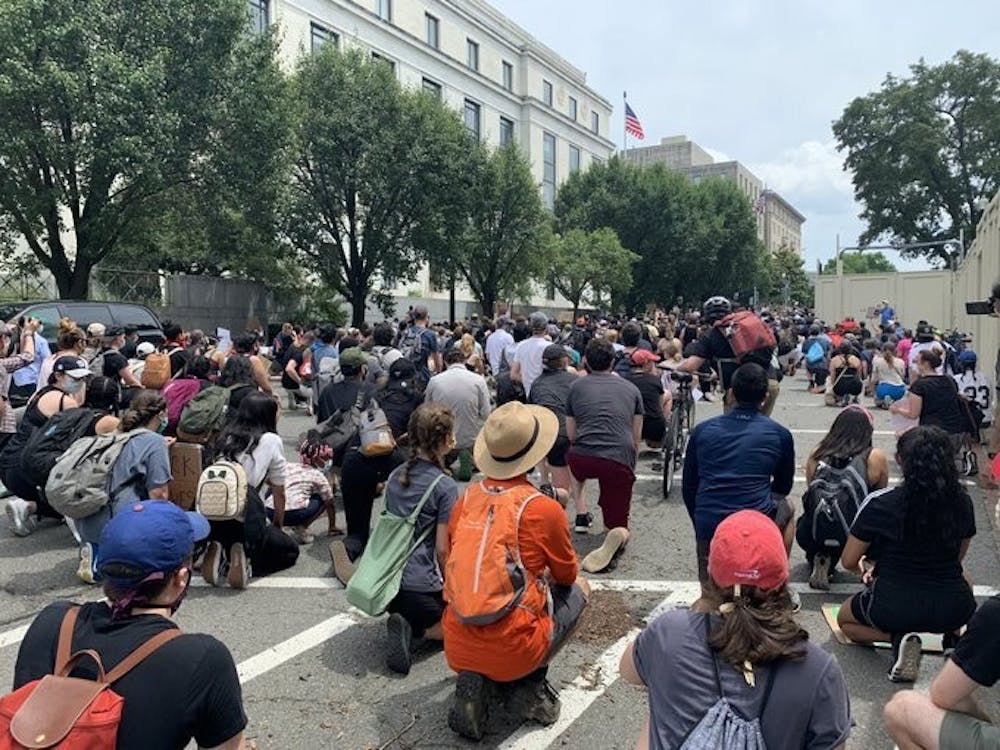As nationwide protests sprung up after the killing of George Floyd by police in Minneapolis, journalists including American University alumni documented the demonstrations and the response by law enforcement in the D.C. region.
Chelsea Cirruzzo, a health reporter for InsideHealthPolicy and freelance journalist who graduated from AU in 2017 with a bachelor’s degree in public relations, covered several D.C. protests in late May and early June.
Cirruzzo said that the first story she worked on regarding the protests, which was published by DCist, focused on the operations of D.C. businesses as the city began to reopen after the shutdown, due to the spread of the coronavirus. She immediately found that District residents and business owners were supportive of the protests, even among those who were not in the streets.
“Some of the businesses had their windows broken or whatnot,” Cirruzzo said. “So I actually spoke to Founding Farmers about it and they were like, ‘Oh, windows are fine, it's totally fine.’”
Cirruzzo said that the city’s curfew, which conflicted with the June 2 primary election, presented another opportunity to see how the protests were affecting people in D.C.
“I helped with the overall election night coverage,” Cirruzzo said. “People were standing in line after curfew, and we wanted to know how they got out to vote, both during the protests and a pandemic."
Lauren Lumpkin, who earned her bachelor’s and master’s degrees from AU’s School of Communication, now reports for The Washington Post in Baltimore and found herself covering both D.C. and Baltimore protests.
“I just love being out there and talking to people and being able to document what's going on,” Lumpkin said. “It's history being made, and it's really a privilege to be on the frontlines of that happening and be able to document that so people can read about it, you know, two years from now.”
Lumpkin said that her coverage helped her gain perspective on how the protests changed both over time and across cities.
“First of all, in D.C., the crowds were bigger. But I also think the protests in Baltimore were a lot more peaceful. You know, there were skirmishes with police, and there were instances where they were spraying pepper spray, but there wasn’t much chaos happening.”
Neither Cirruzzo nor Lumpkin majored in journalism as undergraduates, but they found themselves quickly drawn to the profession. For Lumpkin, reporting on a 2017 racist hate crime on AU’s campus as a staff writer for the then-relatively new publication The Blackprint, stood out to her as a key moment in her journalism career.
“During all the protests, it was just something that was affecting me very personally, as a Black student, with a feeling of wanting to kind of contribute to what was going on,” Lumpkin said. “The thing that made me feel less hopeless about the whole situation was being able to go out and report on it. I think that's probably the moment that really felt like the most impactful on my career.”
While AU alumni covered the protests from the outside, journalists themselves became the focus of news coverage after accounts of police attacking reporters spread across the internet. In the early days and weeks of the protests, concerns about violence against journalists grew quickly as videos emerged of a CNN crew being arrested on air, police shooting pepper balls at a Kentucky TV news team, and an officer in D.C. hitting a cameraman with a riot shield.
Ed O’Keefe, a political correspondent for CBS News, graduated from AU in 2005 with a bachelor’s degree in Communication, Legal Institutions, Economics and Government. He remembered watching the moment when Minneapolis police arrested CNN reporter Omar Jimenez live on air.
“What really bothered me about Omar Jimenez is that, because it was live, it was so transparent that he was doing his job and they were doing theirs, and nobody answered him,” O’Keefe said, referring to the moments before Jimenez’s arrest when he asked police to direct him and his crew to an area where they would be out of the way. “Omar was so clearly in the right, and, to his credit, he went right back to reporting after they let him out of the handcuffs.”
O’Keefe said that he was also troubled by the police’s response to accusations of mistreating journalists. Following Jimenez’s arrest, the Minnesota State Patrol tweeted that the arresting officers did not know that the three members of Jimenez’s crew were members of the press (despite them identifying themselves as journalists live on television) and that they had been released after confirming the identities.
“First of all, where is the evidence of people saying they're reporters when they're not?” O’Keefe said. “Also, when someone says they're a journalist, the First Amendment would suggest they've got the right to do that. There's no list of approved media outlets.”
Lumpkin said that, while she covered the protests, she didn’t see any blatant violence toward journalists, but police and protesters acted aggressively toward them.
“You know, in my experience, [the police] were just kind of spraying out at the crowd, so they're not hearing anyone identify as press,” Lumpkin said. “And, on the other hand, what happened to me was, I was trying to interview one person. And I guess their friend came up and was like, ‘Who are you? Why are you talking to journalists?’”
Cirruzzo said that all of the protests that she covered were entirely peaceful. She said she read an article in DCist that informed her view of the protests in context with the pandemic.
“Racism is a public health issue too,” Cirruzzo said.





